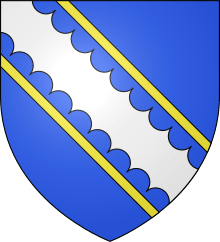Henry Fortescue (Lord Chief Justice)
Sir Henry Fortescue (fl. 1426), was Lord Chief Justice of Ireland.
Sir Henry Fortescue | |
|---|---|
 Arms of Fortescue: Azure, a bend engrailed argent plain cottised or. Motto: Forte Scutum Salus Ducum ("A Strong Shield is the Salvation of Leaders")[1] | |
| Lord Chief Justice of Ireland | |
| In office 25 June 1426 – 1429 | |
| Preceded by | Stephen de Bray |
| Succeeded by | Stephen de Bray |
| Personal details | |
| Father | John Fortescue |
| Relatives | Sir John Fortescue (brother) |
Early life
Fortescue was the eldest son of Sir John Fortescue, appointed in 1422 Captain of the captured Castle of Meaux, 25 miles NE of Paris. The earliest surviving record of the Fortescue family relates to its 12.c. holding of the manor of Wimpstone in the parish of Modbury, Devon. His younger brother was Sir John Fortescue, Lord Chief Justice of England and Wales.
Studies
It is probable that he was a student of Lincoln's Inn, and almost certain that he was elected member of parliament for Devon on 11 November 1421.
Chief Justice
His appointment as Lord Chief Justice of Ireland is dated 25 June 1426, and for a short period his name occurs several times in the Calendar of the Irish Chancery Rolls. From these entries, which contain all that is known of his career, it appears that a salary was assigned to him of forty pounds per annum, which was soon afterwards altered to forty pence per diem, in addition to the custody of certain manors. Fortescue held his appointment only for seventeen months, and was ‘relieved’ from it by the king's writ on 8 November 1427.
Embassy to King Henry VI
Almost immediately afterwards he was commissioned by the Parliament of Ireland to accompany Sir James Alleyn on a mission to England, to lay before the king (Henry VI of England) the grievances of his Irish subjects. Again, in 1428, he was sent with Sir Thomas Strange by the lords and commons assembled in Dublin, with the concurrence of Sir John Sutton, the lord-lieutenant, with a number of articles of complaint to be laid again before the king. One of the grievances which he was instructed to represent related to the insults and assaults made upon himself and Sir James Alleyn during their former mission, from which it may be concluded that their first visit to the court had not met with much success. The other griefs for which the parliament prayed redress related to the frequent changes of governors and justices, to the debts left behind them by each successive lord-lieutenant, to the exclusion of Irish law students from the English Inns of Court, and to the treatment of Irishmen travelling in England. There is no further mention of Fortescue in the ‘Patent Rolls,’ nor is anything known as to his after life, beyond the record of an action brought against him to recover certain lands in Nethercombe, Devonshire.
Other appointments
He was Sheriff of Devon in 1446 and 1452 and Sheriff of Cornwall in 1447.[2]
Marriage and progeny
He was twice married, each time to an heiress:
- Firstly to Joan Boyun (alias Bozun),[3] daughter and heiress of Edmund Boyun of the manor of Wood, in the parish of Woodleigh,[4] South Devon;
- Secondly to the daughter and heiress of Nicholas de Fallopit of the manor of Fallopit in the parish of East Allington, South Devon.
He left sons by each wife, who each inherited their respective mother's properties, and founded two branches of the Devonshire family of Fortescue. The Fallopit branch soon ended in an heiress, Elizabeth Fortescue, who took the manor by marriage to her cousin Lewis Fortescue (d.1545), a younger son of the Fortescues of Spridleston, in Brixton, Devon, who was a Baron of the Exchequer under King Henry VIII.[5] Their descendant, Anne Hals, married the Rev John Tindal, father of Dr Matthew Tindal and great great grandfather of Sir Nicholas Conyngham Tindal, Chief Justice of the Common Pleas.[6]
References
- Debrett's Peerage, 1968, p.461
- "FORTESCUE, Henry (d.c.1458), of Wood Barton in Woodleigh and Fallapit in East Allington, Devon". Parliamentary History online. Retrieved 28 December 2011.
- Vivian, Lt.Col. J.L., (Ed.) The Visitations of the County of Devon: Comprising the Heralds' Visitations of 1531, 1564 & 1620, Exeter, 1895, p.353
- Risdon, Tristram (d.1640), Survey of Devon, 1811 edition, London, 1811, with 1810 Additions, p.181
- 'General history: Extinct baronets', Magna Britannia: volume 6: Devonshire (1822), pp. CXXIII-CXXXII. URL: http://www.british-history.ac.uk/report.aspx?compid=50552
- 'Tindal of Chelmsford'
![]()
| Parliament of England | ||
|---|---|---|
| Preceded by Sir Hugh Courtenay Robert Cary |
Member of Parliament for Devon 1421 With: John Copplestone |
Succeeded by William Bonville Robert Cary |
| Legal offices | ||
| Preceded by Stephen de Bray |
Lord Chief Justice of Ireland 1426–1429 |
Succeeded by Stephen de Bray |
| Political offices | ||
| Preceded by Nicholas Broughton |
High Sheriff of Devon 1446–1477 |
Succeeded by Thomas Buttokessyde |
| Preceded by John Austell |
High Sheriff of Cornwall 1447–1448 |
Succeeded by John Trevelyan |
| Preceded by Sir Edward Hill |
High Sheriff of Devon 1452–1453 |
Succeeded by John Cheney |